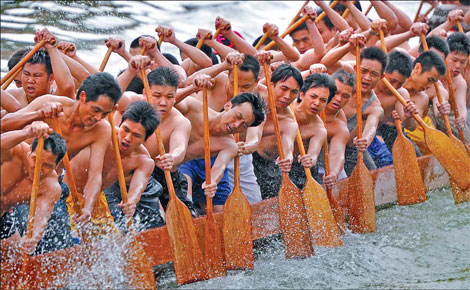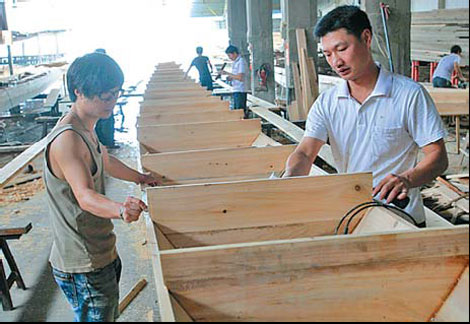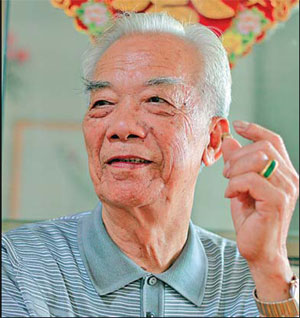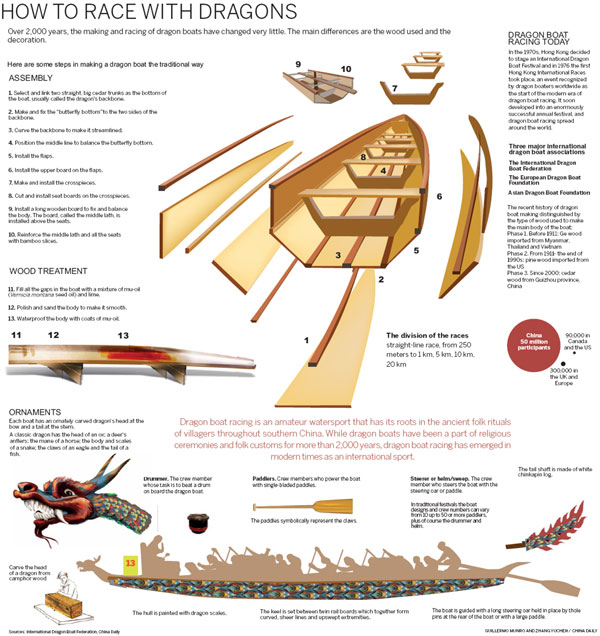Keeping it in the family
 |
|
A dragon boat race in Guangzhou, capital of Guangdong province, on June 18. Provided to China Daily |
?
 |
|
Workers in Feng Huainu's boatyard are busy building dragon boats to meet the needs of this month's dragon boat racing in Guangdong province. Zou Zhongpin / China Daily |
Secrets passed from generation to generation have preserved a tradition for thousands of years, reports Zhang Yuchen in Dongguan, Guangdong province.
Following the slow rasping of a saw as it cuts through wood leads to large wooden shed with a slipway down to the river. It's dark inside. Sawdust dances in the shaft of sunlight that parts the shadows where several men are working on the ribs of a boat. Feng Huainu sits quietly in a corner watching the men working. It is the busiest season for the 82-year-old's boatyard, as they have to finish all the boats in time for Dragon Boat Festival. It usually takes eight days to finish one boat. And they must leave the boat to rest for a couple of days before it is launched.
"The big advantage of my boatyard is the speed with which we can build a boat," Feng said.
The skills required to build dragon boats have been passed down from generation to generation and they are carefully guarded so they never leak to other families. Feng learned how to make dragon boats from his father, and his eight workers are all close relatives, including one of his sons and one of his grandsons.
At one time, all three of Feng's sons worked in the boatyard under his supervision but now only one, Peichao, carries on the family tradition.
"My brothers were asked to help with my sister's business in the town," said Feng Peichao, measuring the width of the dragon's belly he is working on. "They had the good luck to go for alternatives."
"But among all my siblings, my boat-building techniques are the best," he added proudly.
 |
|
Feng Huainu, 82, is one of a few dragon boat masters in Guangdong province. Zou Zhongpin / China Daily |
He says making a dragon boat is hard work and no one would choose to do it if they had an easier option.
Feng Huainu began to learn how to build dragon boats at the age of 12 and wanted to go to Hong Kong where he could earn more money, but his father forbade him as he needed him to help make boats to support the family of nine children.
In 1950, Feng and the other dragon boat builders were sent to work in a State-owned shipyard in Guangdong producing large wooden ships as well as small boats. Feng took his job seriously and worked hard.
"I was honored as the highest rank of worker by the nation," he said, smiling proudly.
Occasionally people in the neighboring communities would come and find him and ask him to build them a dragon boat. But during the "cultural revolution" (1966-76) Feng had to build them in secret as public ceremonies among local residents were forbidden.
But knowing how important dragon boats are to the lives of the local people, Feng never refused to make one. He found some willing helpers and built the boats under the cover of the banana trees.
Once finished, the boats would be covered and transported to the person who ordered it. After the festival the boat would be painted in thick layers of varnish made from the seeds of mu-oil trees (Vernicia montana) and then buried until the festival next year.
Waking the dragons
Feng's boatyard is located in Dongxiang village, Zhongtang township, in the Pearl River Delta region of Guangdong province in southern China, where dragon boats can be traced back 2,000 years.
In late May or early June, Zhongtang celebrates its biggest community activity called Longzhou Jing, when all the dragon boats from different villages gather on the river.
Before a boat is first launched, the residents of the village that ordered it will come to the boatyard to "wake up" the dragon with a grand ceremony. They select a representative who waters the whole body of the dragon with lemongrass water and then carefully cleans the head of the dragon. The villagers who will paddle the boat then wash their hands with the same lemongrass water. Then the eyes of the dragon are painted with the blood of a cockerel.
Then villagers standing on both sides of the boat collectively pat the dragon's body to wake it up and carry it on their shoulders to the water. Then to the accompanying rat-a-tat-tat of firecrackers the dragon is vigorously paddled through the water.
In a place such as Zhongtang, where the villages are built along the river so the water flows in front of the houses, dragon boats have become a key ceremonial element on other special days, such as weddings.
"A wedding ceremony is a good opportunity to see dragon boats," said Ye Jiaming, an official in charge of intangible cultural heritage management and promotion in Zhongtang. "Every village will send a dragon boat to the wedding to celebrate and share the happiness with the new couple, as well as to show off the prosperity of their own place."
So there is always a need for dragon boats and the masters that make them.
Twists on tradition
Feng now lives a life of tranquility with his wife. While his wife watches Cantonese opera on TV, Feng sits at a table outside watching the young boat makers.
Feng's boatyard specializes in building boats in the traditional style, which means adhering to strict standards. Modern boats that deviate from the standard, being longer or shorter, narrower or wider, are ugly in Feng's eyes and he calls them "phantom boats".
Other changes to the dragon boat races that Feng has witnessed include the gender of participants. Women were traditionally prohibited from boarding any dragon boat. However, in 1984, women first appeared in a dragon boat race in Hong Kong.
Now in the corner of Feng's boatyard, there are a few smaller boats, which he calls "Phoenix Boats", that compete with 16 female paddlers.
The demand for lighter, quicker boats means that all Feng's boats are now made of cedar transported from Guizhou province, which is light but not very durable. The boats last only two or three years.
"Before, the wood was Douglas Fir from the United States, which was very heavy and durable," said Feng. "A boat would last about 10 years."
The older generation of boat builders is intent on preserving the old traditions, where dragon boat masters build a boat with only their rich experience and intuition to guide them.
"I will never use the computer to design boats," said Huo Zhuoxing, 42, another dragon boat master.
But with more options available to them the younger generation is less likely to follow in the family footsteps.
"Fewer and fewer young people get involved in the boat building process, although there are still many local residents that cling to the tradition," said Ye.
Huo's son became a civil servant in Zhongtang after graduating from the university.
But asked whether or not he felt concerned about the future of dragon boat making, Feng shook his head and said, "I'm not worried. The local residents love dragon boats and it has lasted for centuries."
Contact the writer at zhangyuchen@chinadaily.com.cn





















